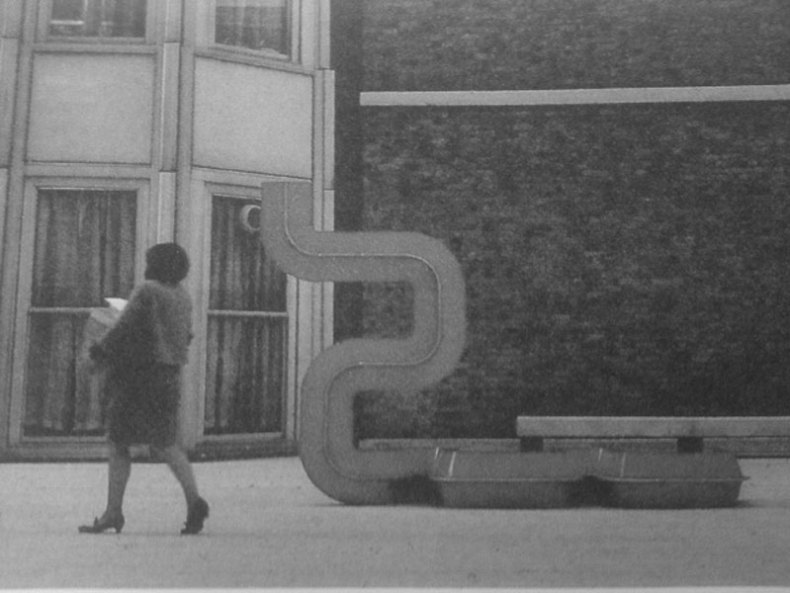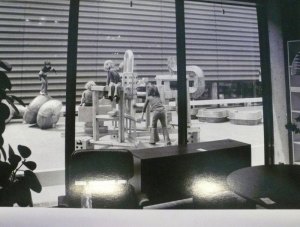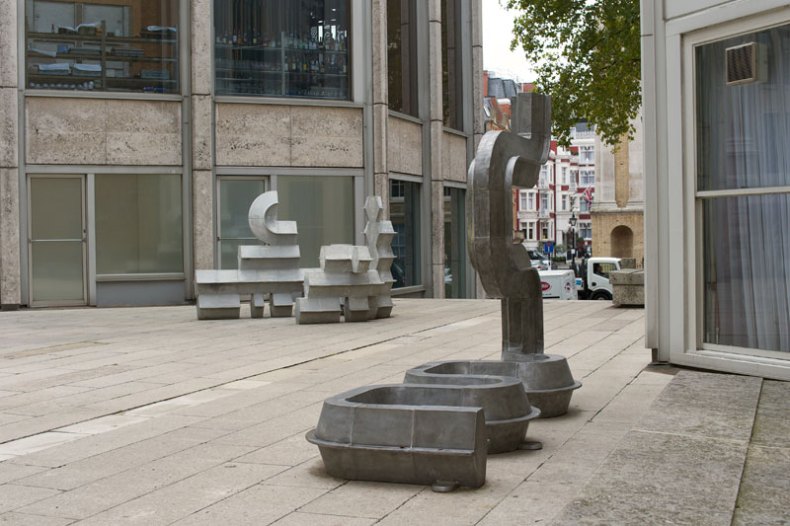Forty-seven years after it was first at the site, Eduardo Paolozzi’s Suwasa (originally titled Es-Es) has returned to the Economist Plaza. Bowman Sculpture brought the piece back in late 2014, rekindling a historic connection between the sculpture and its surroundings. Will it stay for good this time?

Image courtesy Bowman Sculpture
The Economist Plaza was designed by Alison and Peter Smithson in 1964. The Smithsons were Paolozzi’s friends and collaborators, a relationship that dated back to their days in the Independent Group (a cross-disciplinary group of architects, designers, theorists, photographers, painters and sculptors that met at the ICA from 1952–5). After its first spell in the plaza, Suwasa was recycled into a work for Terence Conran’s Habitat store in Wallingford in 1973–4. There it joined a group of Paolozzi sculptures to form a children’s playground. This was sculpture that could be touched and climbed on. While parents shopped and lunched, children were offered a non-commercial space where objects were something to explore, not consume.

Image courtesy Bowman Sculpture
Suwasa has returned to the Economist Plaza accompanied by Trishula and Kalasan, two other sculptures that formed the playground in Wallingford. Although the plaza may seem a long cry from the landscape of the playground, in fact children, play and the city are themes that recur in the work of the Smithsons. In 1953 the Smithsons became part of a group of architects known as Team 10 which included the Dutch playground designer Aldo van Eyck. Van Eyck and the Smithsons shared a concern with the child’s absence in urban planning.
The sculptures are currently a stone’s throw from the Royal Academy (where Paolozzi was an academician) and a short stroll from Tottenham Court Road Station where Paolozzi’s arch mosaics have been removed to much public consternation. Amidst the hustle and bustle of Green Park and Piccadilly Circus, the sculptures are caught in a commercial hub, just as they had been in Wallingford. But once again they have the potential to offer an antidote: a non-commercial site that makes space for a creative interaction with place.

eduardo_paolozzi_suwasa_1966-2 Image courtesy Bowman Sculpture
Perhaps TFL and the architectural practice Hawkins/Brown could compensate London for the loss of the mosaics and gift the sculptures to London as a permanent fixture?
Related Articles
Comings and Goings: Paolozzi and public art (Gillian Darley)

The public Paolozzi that should stay; especially after the saga at Tottenham Court Road
Suwasa (1966), Eduardo Paolozzi. Courtesy Bowman Sculpture
Share
Forty-seven years after it was first at the site, Eduardo Paolozzi’s Suwasa (originally titled Es-Es) has returned to the Economist Plaza. Bowman Sculpture brought the piece back in late 2014, rekindling a historic connection between the sculpture and its surroundings. Will it stay for good this time?
Image courtesy Bowman Sculpture
The Economist Plaza was designed by Alison and Peter Smithson in 1964. The Smithsons were Paolozzi’s friends and collaborators, a relationship that dated back to their days in the Independent Group (a cross-disciplinary group of architects, designers, theorists, photographers, painters and sculptors that met at the ICA from 1952–5). After its first spell in the plaza, Suwasa was recycled into a work for Terence Conran’s Habitat store in Wallingford in 1973–4. There it joined a group of Paolozzi sculptures to form a children’s playground. This was sculpture that could be touched and climbed on. While parents shopped and lunched, children were offered a non-commercial space where objects were something to explore, not consume.
Image courtesy Bowman Sculpture
Suwasa has returned to the Economist Plaza accompanied by Trishula and Kalasan, two other sculptures that formed the playground in Wallingford. Although the plaza may seem a long cry from the landscape of the playground, in fact children, play and the city are themes that recur in the work of the Smithsons. In 1953 the Smithsons became part of a group of architects known as Team 10 which included the Dutch playground designer Aldo van Eyck. Van Eyck and the Smithsons shared a concern with the child’s absence in urban planning.
The sculptures are currently a stone’s throw from the Royal Academy (where Paolozzi was an academician) and a short stroll from Tottenham Court Road Station where Paolozzi’s arch mosaics have been removed to much public consternation. Amidst the hustle and bustle of Green Park and Piccadilly Circus, the sculptures are caught in a commercial hub, just as they had been in Wallingford. But once again they have the potential to offer an antidote: a non-commercial site that makes space for a creative interaction with place.
eduardo_paolozzi_suwasa_1966-2 Image courtesy Bowman Sculpture
Perhaps TFL and the architectural practice Hawkins/Brown could compensate London for the loss of the mosaics and gift the sculptures to London as a permanent fixture?
Related Articles
Comings and Goings: Paolozzi and public art (Gillian Darley)
Unlimited access from just $16 every 3 months
Subscribe to get unlimited and exclusive access to the top art stories, interviews and exhibition reviews.
Share
Recommended for you
Michelle Obama’s challenge to museums
The First Lady called on US museums to widen access at the Whitney’s ribbon-cutting ceremony
Augmented Reality Meets the Art World
It was only a matter of time before the art world went virtual…
Acquisitions of the Month: April 2015
Pop art for Chicago; a Duchamp archive for Stockholm; and a Dreamhouse for the Dia Art Foundation